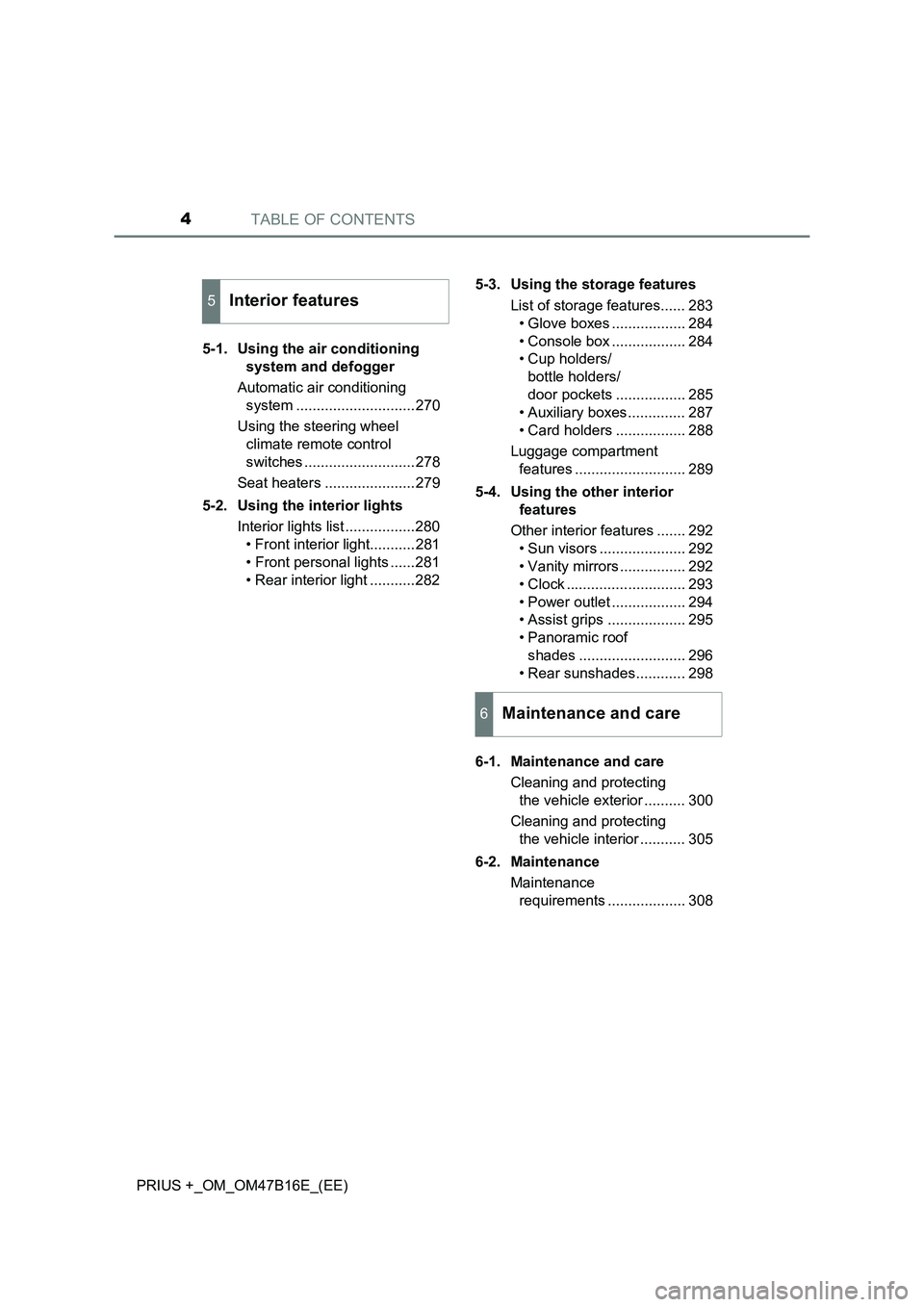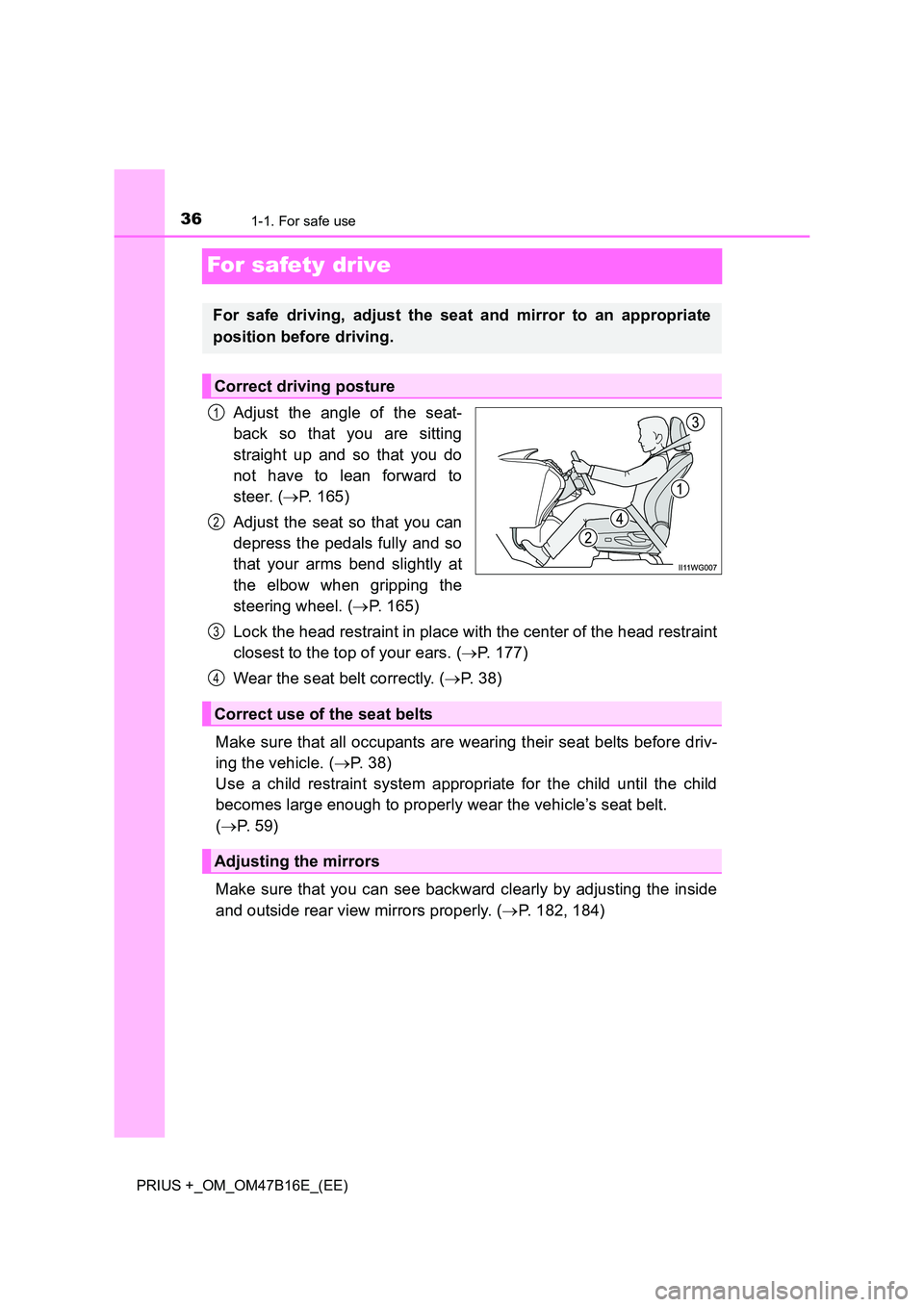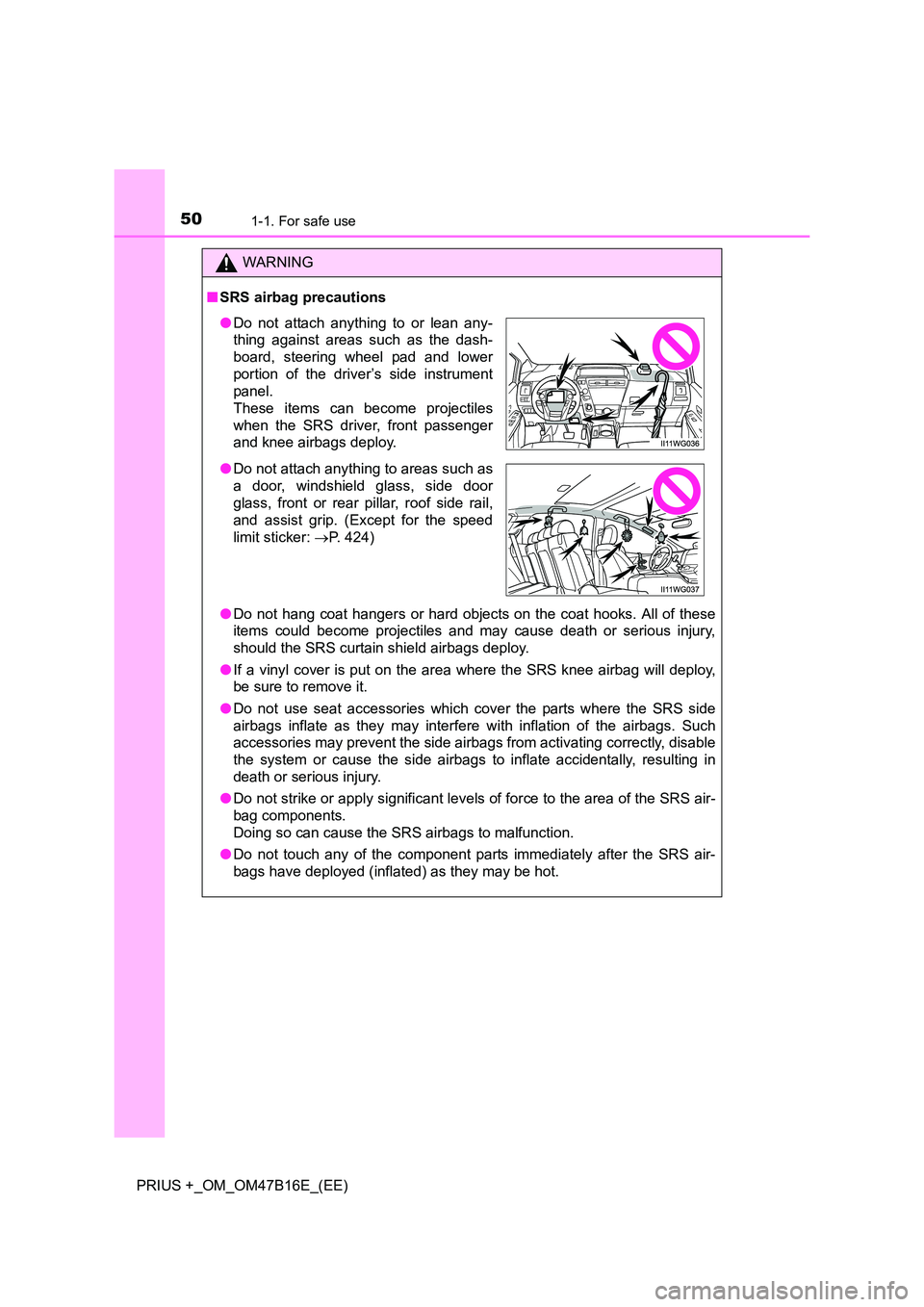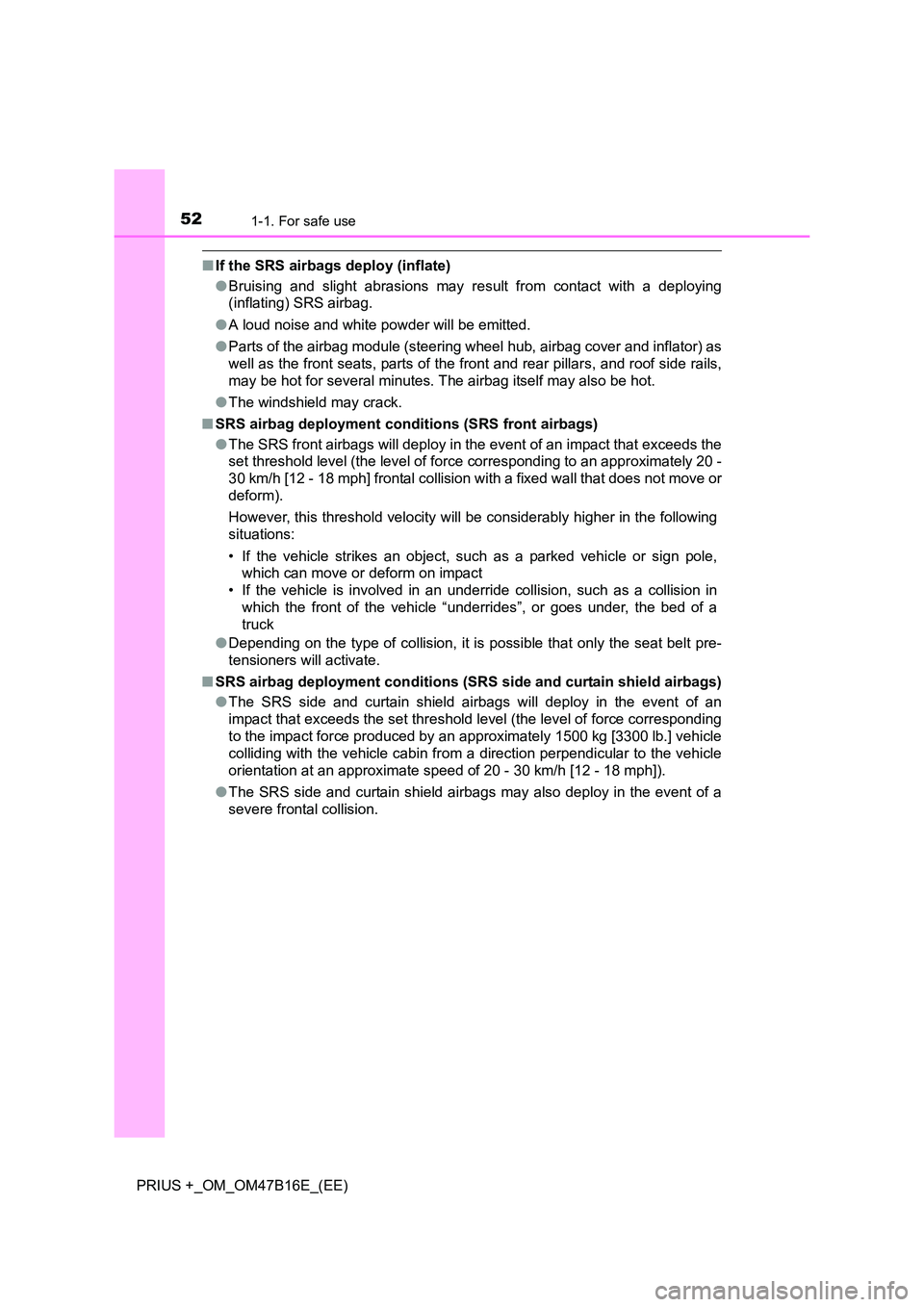2015 TOYOTA PRIUS PLUS wheel
[x] Cancel search: wheelPage 3 of 496

3
1
8 7
6
5
4
3
2
PRIUS +_OM_OM47B16E_(EE)3-4. Adjusting the steering
wheel and mirrors
Steering wheel ...................180
Inside rear view mirror .......182
Outside rear view mirrors .............................184
3-5. Opening and closing the windows
Power windows ..................186
4-1. Before driving Driving the vehicle .............190
Cargo and luggage ............198
Trailer towing .....................200
4-2. Driving procedures Power (ignition) switch .......201
EV drive mode ...................206
Hybrid transmission ...........208
Turn signal lever ................213
Parking brake.....................214 4-3. Operating the lights
and wipers
Headlight switch ................ 215
Fog light switch ................. 218
Windshield wipers and washer ............................ 219
Rear window wiper and washer ............................ 223
4-4. Refueling Opening the fuel tank cap .................................. 224
4-5. Using the driving support systems
Cruise control .................... 227
Dynamic radar cruise control ............................. 231
Driving mode select switch .............................. 247
Driving assist systems....... 248
PCS (Pre-Crash Safety system) ........................... 254
4-6. Driving tips Hybrid vehicle driving tips .................................. 262
Winter driving tips.............. 265
4Driving
Page 4 of 496

TABLE OF CONTENTS4
PRIUS +_OM_OM47B16E_(EE)5-1. Using the air conditioning
system and defogger
Automatic air conditioning system .............................270
Using the steering wheel climate remote control
switches ...........................278
Seat heaters ......................279
5-2. Using the interior lights Interior lights list .................280• Front interior light...........281
• Front personal lights ......281
• Rear interior light ...........282 5-3. Using the storage features
List of storage features...... 283• Glove boxes .................. 284
• Console box .................. 284
• Cup holders/bottle holders/
door pockets ................. 285
• Auxiliary boxes .............. 287
• Card holders ................. 288
Luggage compartment features ........................... 289
5-4. Using the other interior features
Other interior features ....... 292 • Sun visors ..................... 292
• Vanity mirrors ................ 292
• Clock ............................. 293
• Power outlet .................. 294
• Assist grips ................... 295
• Panoramic roof shades .......................... 296
• Rear sunshades............ 298
6-1. Maintenance and care Cleaning and protecting the vehicle exterior .......... 300
Cleaning and protecting the vehicle interior ........... 305
6-2. Maintenance Maintenance requirements ................... 308
5Interior features
6Maintenance and care
Page 5 of 496

5
1
8 7
6
5
4
3
2
PRIUS +_OM_OM47B16E_(EE)6-3. Do-it-yourself maintenance
Do-it-yourself service precautions ......................311
Hood ..................................313
Positioning a floor jack .......315
Engine compartment..........317
12-volt battery ....................327
Tires ...................................331
Tire inflation pressure ........343
Wheels ...............................345
Air conditioning filter ..........347
Wiper rubber replacement .....................349
Electronic key battery ........351
Checking and replacing fuses ................................353
Light bulbs .........................357
7-1. Essential information Emergency flashers ...........368
If your vehicle has to be stopped in an
emergency .......................369 7-2. Steps to take in an
emergency
If your vehicle needs to be towed ..................... 370
If you think something is wrong .............................. 375
If a warning light turns on or a warning buzzer
sounds ............................ 376
If a warning message is displayed ......................... 388
If you have a flat tire (vehicles with a
spare tire) ........................ 404
If you have a flat tire (vehicles without a
spare tire) ........................ 418
If the hybrid system will not start ........................... 435
If the electronic key does not operate properly ........ 437
If the 12-volt battery is discharged ...................... 439
If your vehicle overheats ........................ 444
If the vehicle becomes stuck................................ 449
7When trouble arises
Page 36 of 496

361-1. For safe use
PRIUS +_OM_OM47B16E_(EE)
For safety drive
Adjust the angle of the seat-
back so that you are sitting
straight up and so that you do
not have to lean forward to
steer. (→P. 165)
Adjust the seat so that you can
depress the pedals fully and so
that your arms bend slightly at
the elbow when gripping the
steering wheel. ( →P. 165)
Lock the head restraint in place with the center of the head restraint
closest to the top of your ears. ( →P. 177)
Wear the seat belt correctly. ( →P. 3 8 )
Make sure that all occupants are wearing their seat belts before driv-
ing the vehicle. ( →P. 3 8 )
Use a child restraint system appropriate for the child until the child
becomes large enough to properly wear the vehicle’s seat belt.
( → P. 5 9 )
Make sure that you can see backward clearly by adjusting the inside
and outside rear view mirrors properly. ( →P. 182, 184)
For safe driving, adjust the seat and mirror to an appropriate
position before driving.
Correct driving posture
1
2
Correct use of the seat belts
Adjusting the mirrors
3
4
Page 48 of 496

481-1. For safe use
PRIUS +_OM_OM47B16E_(EE)
WARNING
■ SRS airbag precautions
Observe the following precautions regarding the SRS airbags.
Failure to do so may cause death or serious injury.
●The driver and all passengers in the v ehicle must wear their seat belts
properly.
The SRS airbags are supplemental devices to be used with the seat belts.
● The SRS driver airbag deploys with considerable force, and can cause
death or serious injury especially if the driver is very close to the airbag.
Since the risk zone for the driver’s airbag is the first 50 - 75 mm (2 - 3 in.)
of inflation, placing yourself 250 mm ( 10 in.) from your driver airbag pro-
vides you with a clear margin of safety. This distance is measured from
the center of the steering wheel to your breastbone. If you sit less than
250 mm (10 in.) away now, you can change your driving position in sev-
eral ways:
• Move your seat to the rear as far as you can while still reaching the ped- als comfortably.
• Slightly recline the back of the seat. Although vehicle designs vary, many drivers can achieve the 250 mm
(10 in.) distance, even with the driver seat all the way forward, simply by
reclining the back of the seat somewhat. If reclining the back of your
seat makes it hard to see the road, raise yourself by using a firm, non-
slippery cushion, or raise the seat if your vehicle has that feature.
• If your steering wheel is adjustable, tilt it downward. This points the air- bag toward your chest instead of your head and neck.
The seat should be adjusted as recommended above, while still maintaining
control of the foot pedals, steering wheel, and your view of the instrument
panel controls.
● The SRS front passenger airbag also deploys with considerable force, and
can cause death or serious injury especially if the front passenger is very
close to the airbag. The front passenger seat should be as far from the air-
bag as possible with the seatback adjusted, so the front passenger sits
upright.
● Improperly seated and/or restrained infants and children can be killed or
seriously injured by a deploying airbag. An infant or child who is too small
to use a seat belt should be properly secured using a child restraint sys-
tem. Toyota strongly recommends that all infants and children be placed in
the rear seats of the vehicle and proper ly restrained. The rear seats are
safer for infants and children than the front passenger seat. ( →P. 59)
Page 50 of 496

501-1. For safe use
PRIUS +_OM_OM47B16E_(EE)
WARNING
■ SRS airbag precautions
●Do not hang coat hangers or hard objects on the coat hooks. All of these
items could become projectiles and may cause death or serious injury,
should the SRS curtain shield airbags deploy.
● If a vinyl cover is put on the area where the SRS knee airbag will deploy,
be sure to remove it.
● Do not use seat accessories which cover the parts where the SRS side
airbags inflate as they may interfere with inflation of the airbags. Such
accessories may prevent the side airbags from activating correctly, disable
the system or cause the side airbags to inflate accidentally, resulting in
death or serious injury.
● Do not strike or apply significant levels of force to the area of the SRS air-
bag components.
Doing so can cause the SRS airbags to malfunction.
● Do not touch any of the component parts immediately after the SRS air-
bags have deployed (inflated) as they may be hot.
●Do not attach anything to or lean any-
thing against areas such as the dash-
board, steering wheel pad and lower
portion of the driver’s side instrument
panel.
These items can become projectiles
when the SRS driver, front passenger
and knee airbags deploy.
● Do not attach anything to areas such as
a door, windshield glass, side door
glass, front or rear pillar, roof side rail,
and assist grip. (Except for the speed
limit sticker: →P. 424)
Page 51 of 496

511-1. For safe use
1
PRIUS +_OM_OM47B16E_(EE)
For safety and security
WARNING
■ SRS airbag precautions
●If breathing becomes difficult after the SRS airbags have deployed, open a
door or window to allow fresh air in, or leave the vehicle if it is safe to do
so. Wash off any residue as soon as possible to prevent skin irritation.
● If the areas where the SRS airbags ar e stored, such as the steering wheel
pad and front and rear pillar garni shes, are damaged or cracked, have
them replaced by any authorized Toyota dealer or repairer, or another duly
qualified and equipped professional.
■ Modification and disposal of SRS airbag system components
Do not dispose of your vehicle or perform any of the following modifications
without consulting any authorized Toyota dealer or repairer, or another duly
qualified and equipped professional. The SRS airbags may malfunction or
deploy (inflate) accidentally, causing death or serious injury.
●Installation, removal, disassembly and repair of the SRS airbags
● Repairs, modifications, removal or replacement of the steering wheel,
instrument panel, dashboard, seats or seat upholstery, front, side and rear
pillars or roof side rails
● Repairs or modifications of the front fender, front bumper, or side of the
occupant compartment
● Installation of a grille guard (bull bar s, kangaroo bar, etc.), snow plows or
winches
● Modifications to the vehicle’s suspension system
● Installation of electronic devices such as mobile two-way radios (RF-trans-
mitter) and CD players
● Modifications to your vehicle for a person with a physical disability
Page 52 of 496

521-1. For safe use
PRIUS +_OM_OM47B16E_(EE)
■If the SRS airbags deploy (inflate)
●Bruising and slight abrasions may result from contact with a deploying
(inflating) SRS airbag.
● A loud noise and white powder will be emitted.
● Parts of the airbag module (steering wheel hub, airbag cover and inflator) as
well as the front seats, parts of the front and rear pillars, and roof side rails,
may be hot for several minutes. The airbag itself may also be hot.
● The windshield may crack.
■ SRS airbag deployment conditions (SRS front airbags)
●The SRS front airbags will deploy in the event of an impact that exceeds the
set threshold level (the level of force corresponding to an approximately 20 -
30 km/h [12 - 18 mph] frontal collision with a fixed wall that does not move or
deform).
However, this threshold velocity will be considerably higher in the following
situations:
• If the vehicle strikes an object, such as a parked vehicle or sign pole,
which can move or deform on impact
• If the vehicle is involved in an underride collision, such as a collision in which the front of the vehicle “underrides”, or goes under, the bed of a
truck
● Depending on the type of collision, it is possible that only the seat belt pre-
tensioners will activate.
■ SRS airbag deployment conditions (SRS side and curtain shield airbags)
●The SRS side and curtain shield airbags will deploy in the event of an
impact that exceeds the set threshold level (the level of force corresponding
to the impact force produced by an approximately 1500 kg [3300 lb.] vehicle
colliding with the vehicle cabin from a direction perpendicular to the vehicle
orientation at an approximate speed of 20 - 30 km/h [12 - 18 mph]).
● The SRS side and curtain shield airbags may also deploy in the event of a
severe frontal collision.